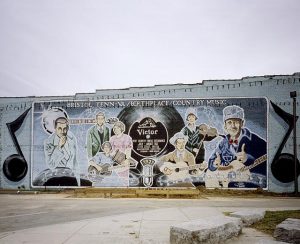Mismatched faces loom down at passersby in Dothan, Alabama. Some grinning, some straight-faced, sixteen white ovals are superimposed on each other. The mural’s array of country music artists is reminiscent of a bad photoshop job. I will argue that our conception of country music as a genre is just as piecemeal and whitewashed.
Wes Hardin’s 2010 mural presents a myriad of flat, disconnected faces and instruments that are meant to represent country music as a whole. These individual, one-dimensional shapes are imposed on a vaguely southern, pastoral backdrop. This representation of country music is almost exactly what we encounter in written attempts to describe the genre. As Jeffrey Manuel points out, the history of country music is intertwined with a “set of ideals and customs” prescribed to the “plain white folk”.1 These plain white folk themselves are often given a physical description: “Fat or lean, blonde or brunet, the Southern type could be discerned by travelers”.2
Written histories have taken perceived elements of white folk culture, pasted them onto a general image of white folk, oriented the whole scene in a generic Southern landscape, and called it country music. Perhaps the ridiculousness of a mural in Alabama with sixteen heads of varying sizes shows us how this description is a mere caricature of country music.
Meanwhile, in Bristol, Virginia, a similar sight meets our eyes. Yet another mural depicts symbols of country music painted together onto a brick wall. More white figures holding guitars and banjos dominate the scene, reinforcing the public perception of country music as a genre of the “plain white folk”. This mural, created by Tim and Murphy White, reveals another element of our perception of country music as well. The words at the top claim the town as a “birthplace” of country music, seeming to attribute a whole genre to a few white guys in a southern town. While most people are aware that the genre’s origins aren’t quite so easy to pin down, this mythology of country music as a genre spawned by some white folk in the rural south is still pervasive. The use of white figures and common symbols of country music such as the banjo to represent the genre only perpetuates this view.
Murals such as those in Alabama and Virginia show us an image of country music that is easy to swallow. They depict a genre that can be neatly boxed up and captured by a mythical sense of southern, white culture. But as Jeffrey Manuel points out, no genre of music is ever this easily defined. We need to move past thinking that such basic tropes of southern culture can characterize an entire history and genre of music.
Works Cited:
Hardin, Wes. Country Music, 2010. The George F. Landegger Collection of Alabama Photographs in Carol M. Highsmith’s America. Dothan, Alabama. Accessed September 23, 2019. https://www.loc.gov/pictures/item/2010638471/
Jeffrey Manuel, “The Sound of Plain White Folk? Creating Country Music’s ‘Social Origins,” Popular Music and Society 31, no. 4 (October 2008): 417-431. https://web.a.ebscohost.com/ehost/detail/detail?vid=0&sid=8398ab2f-336c-4f7c-9774-38f59cff1a8a%40sdc-v-sessmgr02&bdata=JnNpdGU9ZWhvc3QtbGl2ZQ%3d%3d#AN=32744849&db=aph
Murphy White and Tim White. Mural to Country Music, 1980-2006. Carol M. Highsmith Archive. Bristol, Virginia. Accessed September 23, 2019. https://www.loc.gov/pictures/item/2011631066/



